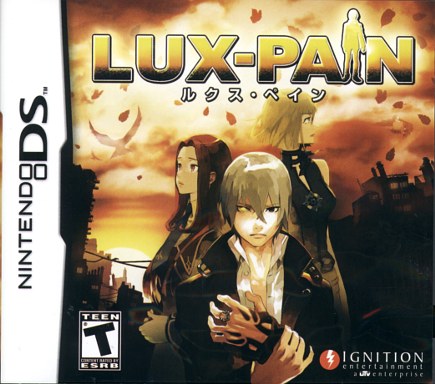
Lux-Pain
We interrupt this DS 'game' to write a review of it.
I have found this so engrossing that it is hard to stop to write a review.
First of all, to me this is not a game, but rather more like
participatory Manga. You are brought into this story as Atsuki Saijo,
a 17 year old whose family was killed by SILENT - a mind parasite
(an internalized spirit or daemon). Having been given special telepathic
powers, he is sent by Fort (the agency fighting these parasites) to Kisaragi
City and enrolled in the high school there, to have a base to investigate
and to root out the original infectee, whose SILENT (by infecting others)
is causing them to join together in mass suicides, or to attack and murder
other citizens.
The story setting is quite elaborate - 7 areas in Kisaragi City, having between
3 and 5 locations each where you can be. So far (and I am only up to day 13 of
the month of October - 17 more to go?) I have met 35 characters and observed
over 40 different screen names in postings on the city's BBS (which can be
read in the internet cafe location). Since Atsuki Saijo is a high school
student, each day during the week starts out at the school, but can then
move to other areas during lunchtime and after school. Since you are the
'new' kid in town (your cover is that you are a 'transfer' student),
you will only slowly get to know your fellow students, teachers, shopkeepers,
and even some policewomen.
Sometimes your telepathic powers will detect current strong thoughts (Shinen)
in others, and you can then scrape away the persons outer subconcious layers
and extract them. Once extracted you can examine them, and having removed them from a
person, that person usually feels relieved and better. The analysis can
lead to uncovering a Silent, which then has to be destroyed. Ultimately you
want to discover the original Silent (I haven't done that yet).
The conversations, worries and emotions expressed by the denizens of Kisaragi
City seem to me to be reasonably in tune with what little I know of Japanese culture -
and it is not really like suburban US high school society. I find this
rather fascinating.
Technically, this DS product is somewhat flawed. The background music is fine and
appropriately themed, and the occasional sound effects (footsteps, phones ringing)
are useful. Most of the conversations and dialog are shown as printed text, but
sometimes there is audio. But, the text usually doesn't quite match the spoken
words, which is both an annoyance and a help. When the two taken together
fill out the meaning, that is good. I think that the original Japanese version
has full spoken conversations; the translations show a sloppyness or haste that
detracts from the story and can be very confusing. In some cases, female characters
are referenced as 'he', and the unpredictable selection of first or last name in
refering to someone can leave you wondering just who they are talking to or about.
The locations themselves are shown as static backdrops, with characters appearing
as drawn figures layered over them, very reminiscent of the style of RPGs. There
is some facial expression, such as changing eyes from open to closed, or mouths from
open to closed, which does help in figuring out who is talking. When the conversation
is displayed as text, a name is placed in a tab above the text box to identify the
speaker.
The save system is good and vital. There are three save slots, and you can choose which
to use. Unless you are in the midst of a cut-scene or a battle with a Silent, you can
almost always get to the save menu by pressing the start button. Proceding through
most actions, conversations, and choosing locations can be done with the A and B buttons
and the D-Pad or with the stylus. Extracting the Shinen (which are refered to as
worms, and are represented by a small wiggly set of connected circles) or subduing a Silent
requires the stylus. If you fail in one of these boss-like fights, pressing the B button
will get you a RETRY option, so you don't have to lose your play since the last save.
When you are examining the extracted thoughts and emotions, they will appear as floating
letters on the upper screen which form phrases and then disperse and form new phrases. Some
of the words may use colored letters, which is OK, except for the use of blue. When a
word is written in blue it is almost always unreadable!
LuxPain comes with a booklet which has over 30 pages of useful information! READ IT.
When I started out, most of it seemed meaningless, but as I progressed, I found
rereading parts of the booklet to be very helpful. Also, there is a great deal of
information in some of the submenus - you can review the conversations, see the
extracted thoughts as stationary lines of text, find out information about each of
the characters (including age, height and weight) along with a representitive picture.
There is an illustrated chart in the booklet showing who is socially connected to
whom in the high school, but I may have to make a bigger chart to include the other
townspeople.
Well, now I'm off to start day 13.
Reviewed by: Lou - 04/09
Ages: Teen
Fun Factor: Unusual and fascinating
Female Factor: Several very strong female characters, including a very spunky 12 year old.
Player Friendly: Lots of detailed information about the story in the booklet and in some submenus, very easy to save.